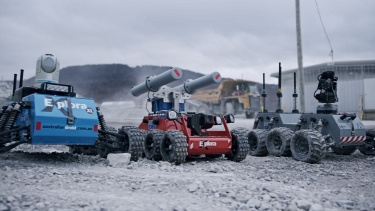At 7am on 13 August, a 70-year-old abandoned portion of a mine in southeastern in United States collapsed and caused an airblast. No one was injured in the incident and everyone was evacuated before the collapse. The mining team needed to assess the condition of the vicinity and reached out to technology teams in the US to assist with the remote inspection but none were able to provide the capability or timeframe to get the mine back into production.
Using ten of their Explora XL robots, Australian Droid & Robot (ADR) reached 1.7km into the mine. The robots conducted a laser and video scan to assist with the mine’s reopening after it collapsed so that production could be restarted.
“We got the call on 22 October,” recalls Australian Droid & Robot co-founder and operations manager Dr Joe Cronin. “From the start, we knew the mine operator’s team were serious and understood what technology was required. We keep a small fleet of robots ready to go for emergencies, but this was going to require more robots and a bunch of different sensors and capability.”
|
|
“We dropped everything and built more robots and then went into a thorough testing regime. To imitate the conditions and distances we would experience in the US, we had teams all over Brisbane in parks and on golf courses ensuring we had the range of communications required. At one stage, we had robots strung across more than one suburb, all controlled from a central location,” says Cronin.
ADR has been developing remote inspection robots using Rajant Kinetic Mesh industrial wireless networking radio technology to create long-distance, low latency networks in real-time. The robots were shipped to the US less than a month later. They were accompanied by head electronics engineer Andre Preller and senior robotics engineer Callum MacDermid.
After testing, the robots entered the mine, each robot relaying the communications signal to the next, creating a high bandwidth, daisy-chain, network.
A week later, the team acquired sufficient data to begin to restart operations.
Acknowledging this as a world-first, Dr Cronin was proud to see the team’s hard work recognised globally.
“All of our technology is designed with the philosophy of ‘safety by separation.’ It guides our work and solidifies our vision. It’s the goal of each of our products to help reduce risk and minimise the need for human intervention within hazardous working environments,” Dr Cronin says.
“We are the only company in the world who was able to safely and quickly mobilise to meet complete deep underground inspections.”
Dr Cronin also credits the support of its technology partners, Rajant and PBE Group, which served as the operation’s communications provider.
“Together, our efforts enabled the robots to transmit 80Mbps, which included high-definition video and Lidar to create a virtual 3D model of the mine, during the longest portions of the mission.”
Dr Cronin considers the achievement as akin to winning gold at the Olympics.
The site mining team and personnel from the Mine Safety and Health Administration are now back, inspecting infrastructure in preparation for the restart of production.
The operator’s project lead explained the company completed a worldwide search for a company to help out.
“ADR’s capability is second to none. The maturity of their technology and the professionalism of their team reflects a strong innovative and entrepreneurial approach to improving mine safety.”











































